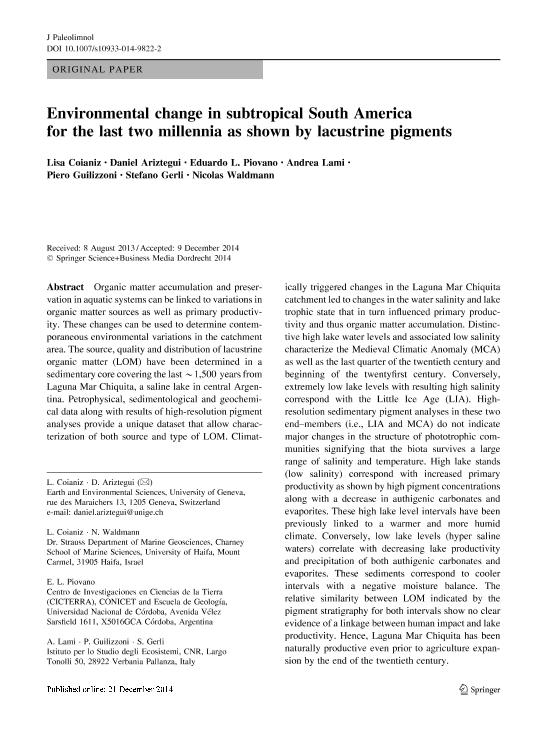Artículo
Environmental change in subtropical South America for the last two millennia as shown by lacustrine pigments
Coianiz, Lisa; Ariztegui, Daniel; Piovano, Eduardo Luis ; Lami, Andrea; Guilizzoni, Piero; Gerli, Stefano; Waldmann, Nicolas
; Lami, Andrea; Guilizzoni, Piero; Gerli, Stefano; Waldmann, Nicolas
 ; Lami, Andrea; Guilizzoni, Piero; Gerli, Stefano; Waldmann, Nicolas
; Lami, Andrea; Guilizzoni, Piero; Gerli, Stefano; Waldmann, Nicolas
Fecha de publicación:
02/2015
Editorial:
Springer
Revista:
Journal Of Paleolimnology
ISSN:
0921-2728
e-ISSN:
1573-0417
Idioma:
Inglés
Tipo de recurso:
Artículo publicado
Clasificación temática:
Resumen
Organic matter accumulation and preservation in aquatic systems can be linked to variations in organic matter sources as well as primary productivity. These changes can be used to determine contemporaneous environmental variations in the catchment area. The source, quality and distribution of lacustrine organic matter (LOM) have been determined in a sedimentary core covering the last ~1,500 years from Laguna Mar Chiquita, a saline lake in central Argentina. Petrophysical, sedimentological and geochemical data along with results of high-resolution pigment analyses provide a unique dataset that allow characterization of both source and type of LOM. Climatically triggered changes in the Laguna Mar Chiquita catchment led to changes in the water salinity and lake trophic state that in turn influenced primary productivity and thus organic matter accumulation. Distinctive high lake water levels and associated low salinity characterize the Medieval Climatic Anomaly (MCA) as well as the last quarter of the twentieth century and beginning of the twentyfirst century. Conversely, extremely low lake levels with resulting high salinity correspond with the Little Ice Age (LIA). High-resolution sedimentary pigment analyses in these two end–members (i.e., LIA and MCA) do not indicate major changes in the structure of phototrophic communities signifying that the biota survives a large range of salinity and temperature. High lake stands (low salinity) correspond with increased primary productivity as shown by high pigment concentrations along with a decrease in authigenic carbonates and evaporites. These high lake level intervals have been previously linked to a warmer and more humid climate. Conversely, low lake levels (hyper saline waters) correlate with decreasing lake productivity and precipitation of both authigenic carbonates and evaporites. These sediments correspond to cooler intervals with a negative moisture balance. The relative similarity between LOM indicated by the pigment stratigraphy for both intervals show no clear evidence of a linkage between human impact and lake productivity. Hence, Laguna Mar Chiquita has been naturally productive even prior to agriculture expansion by the end of the twentieth century.
Archivos asociados
Licencia
Identificadores
Colecciones
Articulos(CICTERRA)
Articulos de CENTRO DE INVEST.EN CS.DE LA TIERRA
Articulos de CENTRO DE INVEST.EN CS.DE LA TIERRA
Citación
Coianiz, Lisa; Ariztegui, Daniel; Piovano, Eduardo Luis; Lami, Andrea; Guilizzoni, Piero; et al.; Environmental change in subtropical South America for the last two millennia as shown by lacustrine pigments; Springer; Journal Of Paleolimnology; 53; 2; 2-2015; 233-250
Compartir
Altmétricas



